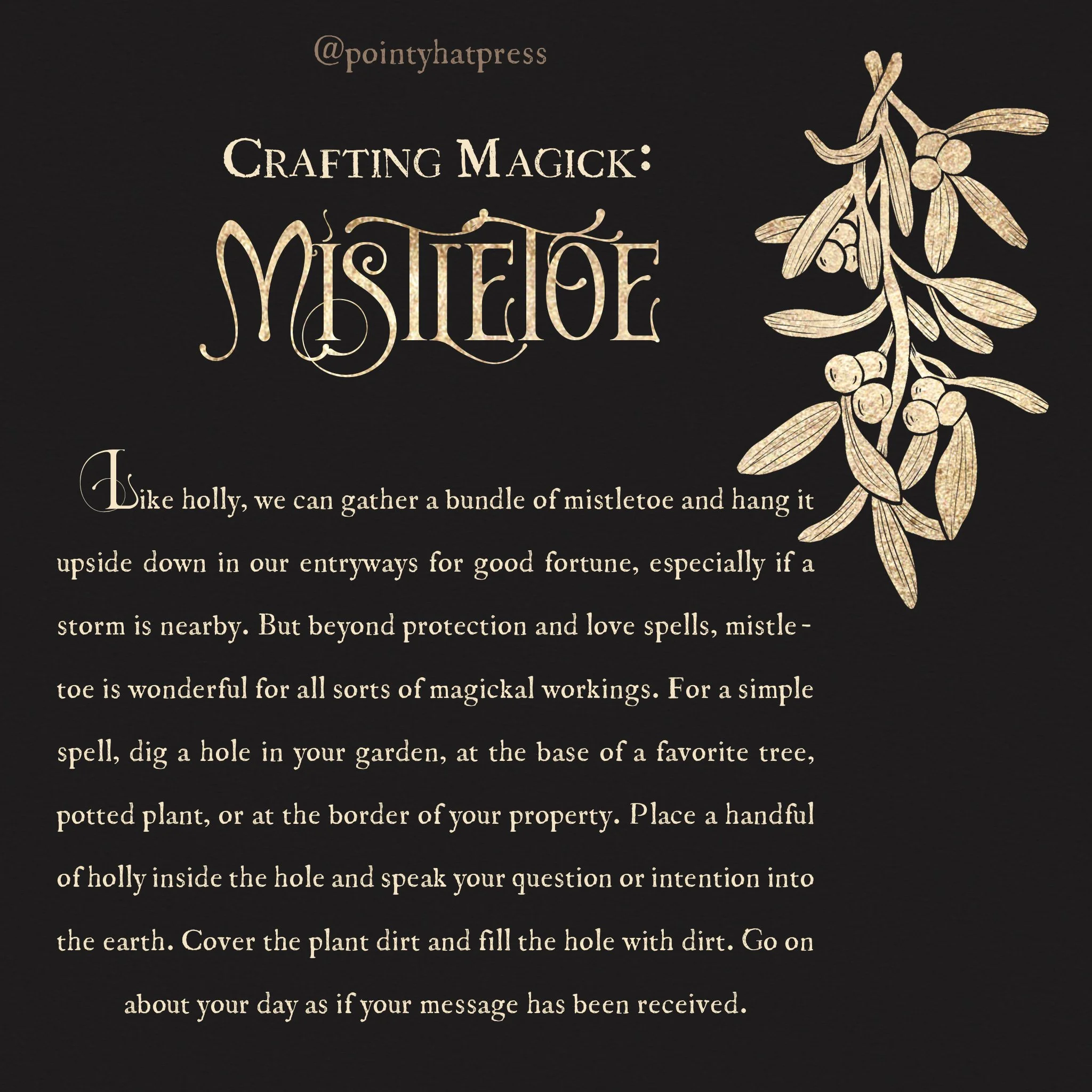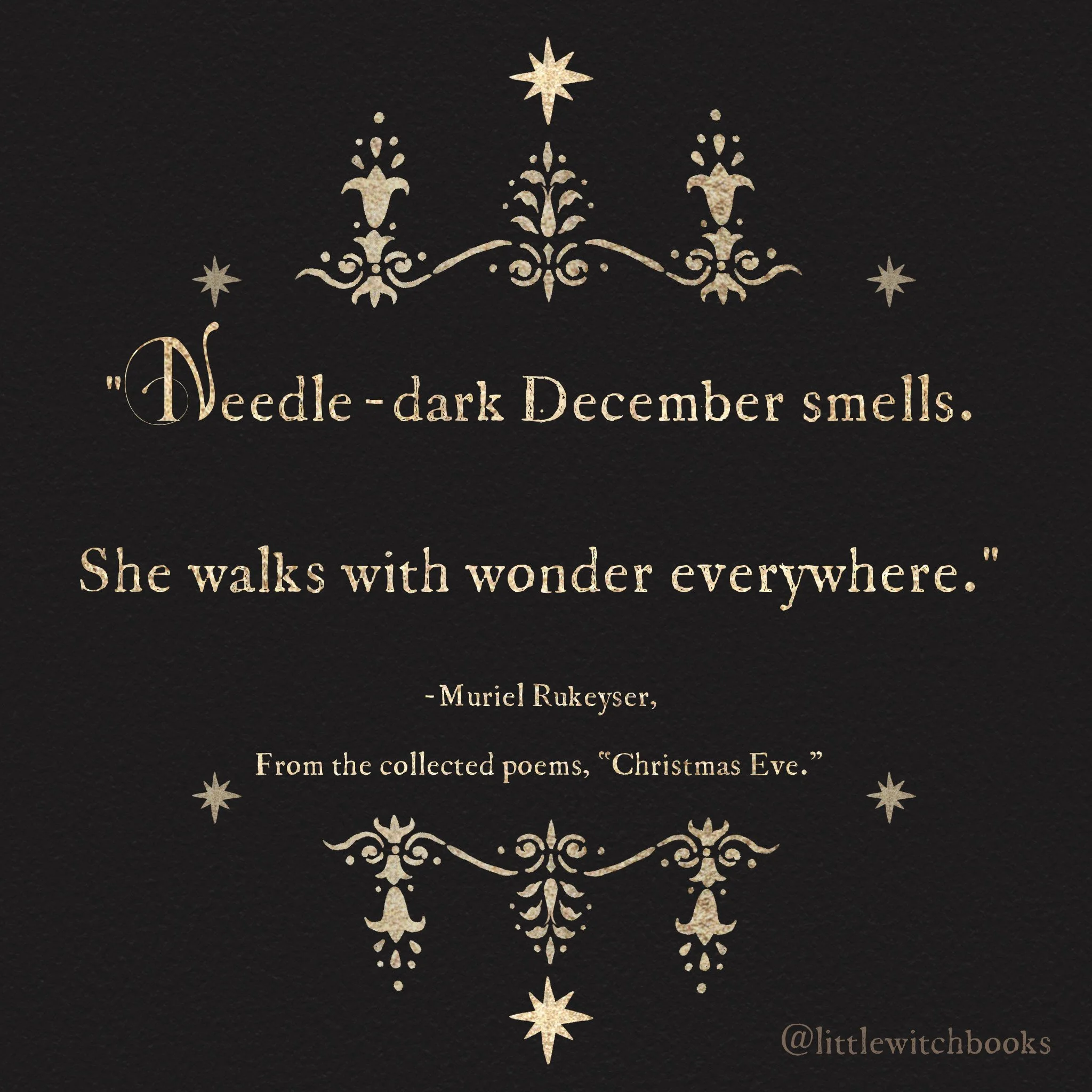The Moon Before Yule
“I'm not sure I'm ready for winter.” Little Witch sighed and looped another garland around the sparkling pine tree. “It's cold, all the trees are sleeping, and the nights are far too long.”
From atop her tinsel-laden perch, Madam Spider tapped an ornament with her scepter. “Nobody is ready for anything!” she stated. “Not even a witch on the full moon!”
Little Witch nodded in agreement. “The full moon does seem to sneak up on us.”
The fairies were collecting tree trimmings and trying to weave them amongst a piece of twine. They had planned to make a wreath, but a couple of steps had gone awry.
“It stills make a lovely…pine bouquet?” Little Witch suggested to the fairies. “Smoke stick? Maybe we leave it as an offering for Brigid? Frau Holle?” Persephone mewed as the girl rested the pine bundle above the hearth. “That's true Persephone, we could add it to our winter altar.”
“Better make up your mind, child,” Madam Spider tsked, “because that's the thing about the Moon Before Yule…” She eyed the nearest window and paused for dramatic effect. The sun was setting but the moon had been up for hours. “It's always listening!”
Little Witch didn't look up from her garland. “But isn't the moon always listening?” she replied.
Madam Spider crossed her arms and retorted, “Isn't the sun always shining?”
“Well…” Little Witch considered her response. Even Madam Spider's sassy remarks usually contained a nugget of wisdom. “I suppose, somewhere in the world, the sun is always shining,” she finally said. “Like right now, in the Southern Hemisphere, the sun is rising, not setting.”
The tiny weaver uncrossed her arms, “I think you get a bit wiser with each full moon,” she said. “You must have some intelligent teachers.” Madam Spider peered into the ornament's reflection and adjusted her crown, “Speaking of sage advice, let me tell you about the mystical, mercurial, Moon Before Yule.”
***
December's moon is known as the Cold Moon, Long Night's Moon, and the Moon Before Yule. Traditionally, the final moon of the year was an invitation to reflect on our struggles and successes, and where we'd like to be in the coming months. In magickal circles, some people use this time to rest and recharge, while others utilize the extra moonlight for lunar magick. Spells related to dreamwork, journeying, and psychic forecasting are popular during the long nights – no matter the moon's phase.
Two weeks after the final full moon of 2022, Yule arrives with glitter, carols, and cauldrons of wintertime brews. But not even our warm fires and sparkly decorations can outshine the moon. Right now, our lunar compass is at her strongest, but the day after Yule, she begins her annual decline. According to Wheel of the Year lore, the Goddess (the moon) gives birth to the God (the sun) at the Winter Solstice. For the next few months, the Goddess will care for the God until he's strong enough to reclaim his heavenly throne in spring. Although the Winter Solstice is often associated with the wise Crone, the longest night of the year is also sacred to the Maiden and Mother faces of the Goddess.
Call it coincidence, intuition, or magick, but we think Little Witch has the right idea when it comes to decorating the solstice altar with a bit of leftover greenery. So get ready for a full moon field trip to the backyard or local nursery, because today we're crafting plant offerings for the Goddess, night-dwellers, and the spirits of winter.
A symbol of immortality and resilience, 16th century Germanic Pagans brought pine and evergreen trees into their homes as beacons of hope, but scholars believe this practice began much earlier. In the Ancient Celtic world, evergreen was present at Midwinter fertility rituals, and in Egypt, people used this plant to beautify their homes. At the Winter Solstice, Egyptians foraged for fresh evergreen and green palm leaves as reminders of the soul's endurance.
Many of us already work with pine and evergreen when we invite a tree into our home and care for it until the start of the new year. In place of a tree, ask friends for their leftover tree cuttings. Use the cuttings to create a wreath, smoke stick, or to embellish a Yule Log. If you come across pinecones this winter, consider making a DIY bird feeder for your animal allies. Simply drizzle some honey or molasses onto the pinecone, sprinkle with nuts and bird seed, and hang from a nearby tree.
A magickal plant with poisonous, red berries, in folklore, holly is associated with Mother Holle, also known as Frau Holle, Hulda, and in some cases, Perchta. In stories, Mother Holle lives in the Otherworld, but curious maidens can access a door to her kingdom at the bottom wells (look for the ones with holly creeping around the base). Mother Holle is an honest grandmother, but she likes hard workers and kind hearts. Depending on how efficient we are, she will either gift us great riches or a kettle of pitch. Legend says that when it snows, Mother Holle is cleaning her house and shaking out her feather blankets..
If we want to invite the fairy folk into our home this winter, craft a holly bouquet for them! Make a couple of extras for friends (they make festive good-luck talismans) and be sure to hang one above your door to deflect unwelcome visitors. For otherworldly guidance, rest a holly twig on your winter altar as an offering to dream guides, Mother Holle, or Mars. Or, craft a holly and ivy crown for Bacchus, Brighid, or one of your muses.
Mistletoe is popular in spells for luck and love, and it was a common ingredient in fertility rites. Legend says that every year, mistletoe arrives in time for the God's birthday – the Winter Solstice. When this plant's leaves begin to age, practitioners use them for divination, as they're believed to highlight unseen opportunities.
Like holly, we can gather a bundle of mistletoe and hang it upside down in our entryways for good fortune, especially if a storm is nearby. But beyond protection and love spells, mistletoe is wonderful for all sorts of magickal workings. For a simple spell, dig a hole in your garden, at the base of a favorite tree, potted plant, or at the border of your property. Place a handful of holly inside the hole and speak your question or intention into the earth. Cover the plant dirt and fill the hole with dirt. Go on about your day as if your message has been received.
Because ivy grows in spirals, it's associated with the Goddess. Ivy possesses the moon's essence and her all-seeing gaze, so ivy-covered houses were said to be magickally safeguarded. Certain birds use ivy leaves and stems to create nests, and the Roman god Bacchus wore an ivy crown. Poets also wore crowns of ivy, not only to show their mastery of language, but to preserve their divine gift.
In the old world, people practiced divination with ivy during the 12 Nights of Yule. The rules were simple: on 1st Night of Yule, ask a question and place an ivy leaf in bowl of water. Over the next week and a half, record any changes to the leaf's appearance. On the 12th day, interpret your findings. However you decipher the ivy's message is up to you, but in the past, a green leaf was believed to be a positive omen, whereas a black or moldy leaf was less favorable.
In addition to Pine, Evergreen, Holly, Mistletoe, and Ivy, Little Witch is also fond of including Apple Trees, Elder, Oak, and all sorts of vines and climbers into her winter moon spells. What plants are showing up in your life right now?
You can see more plant love in our latest folktale, The Scavenger Hunt, and also in the newest addition to the shop – the Moon & Vine Journal. Crafted with magick in mind, the Moon & Vine Journal is part of Pointy Hat Press's Moon & Vine Collection. This 48-page journal is bound with cream white 70lb acid-free paper with a scuff-resistant velvet ultra-matte laminate cover. Because a journal is an essential element in the witch's toolkit, we encourage you to fill the pages with magickal formulas, recipes, and memories. Click here for more details!









